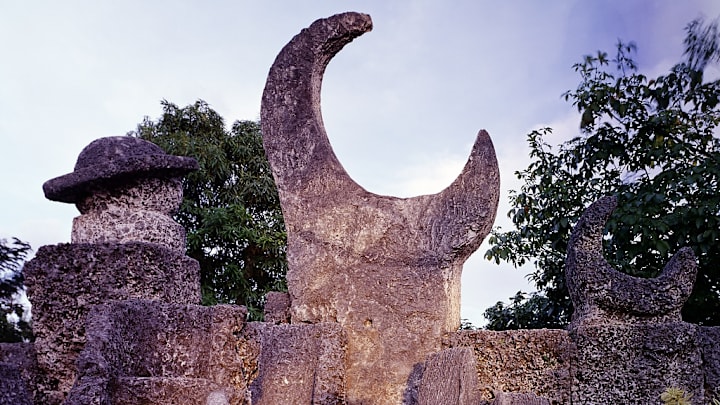Florida’s Coral Castle has been called the American Stonehenge, but a more apt comparison might be the Taj Mahal. The Castle—which is located in Homestead, just outside of Miami—is the obsessive work of Edward Leedskalnin, a Latvian immigrant who spent nearly 30 years building this monument in stone for his “Sweet Sixteen” fiancée, a young woman who jilted him the night before their wedding day.
Heartbroken, Leedskalnin traveled to North America, spending time in Canada, California, and Texas before finally settling in Florida City, Florida in 1918 after coming down with tuberculosis. When he’d recovered, Leedskalnin used the skills he learned coming from a family of stonemasons to quarry, carve, and set huge slabs of oolite limestone—a form of sedimentary rock that often contains small pieces of fossilized shells and coral—all over his property.
Just how he was able to do all of this work by himself using only basic hand tools is a bit of a mystery; he intentionally worked late at night under the cover of darkness to hide his techniques. Some neighborhood snoopers claim to have seen Leedskalnin lay his hands on a block of stone and chant a mysterious incantation, which caused the rock to float in the air. More rational minds think a tripod made of telephone poles and a block-and-tackle pulley system, that’s been seen in photographs, is the more likely method.
No matter how he did it, though, it’s still a pretty amazing feat for a single man to build an eight-foot tall fence around 10 acres of land using stones four feet wide, three feet thick, and weighing more than 55 tons each. In addition, the wall also contains a two-story tower built from blocks that average about nine tons each, for a total of 240 tons. Leedskalnin lived on the second floor, which he furnished with hand carved stone tables, chairs, and a bathtub. In the garden, he built a variety of sculptures, including two 25-foot tall, 28-ton obelisks, and a massive 30-ton rock that has additional decorative stones on the top, eight feet off the ground.
The highlight of this spectacle, though, is a nine-ton, eight-foot tall revolving stone gate set between two segments of the wall with only a quarter inch of clearance on either side. At one time the stone was so precisely balanced on an old truck bearing that it was said a child could spin the gate around with just a finger. When the bearing began to rust and had to be replaced in 1986, it took a team of six men and a 50-ton crane to remove the stone. The gate broke again in 2005, and even with today’s technology, it has never quite worked as smoothly as it had when Leedskalnin built it.
Even more amazing is that Leedskalnin moved the whole kit and kaboodle—by himself—beginning in 1936. Developers were building a subdivision near his property, so Leedskalnin bought 10 acres in nearby Homestead to get away. Using a modified truck chassis, Leedskalnin dismantled his masterpieces at night, including the walls and the tower, and transported them 10 miles north to his new home. The move took him three years, after which he got back to work and expanded the collection even more.
Leedskalnin called his home Rock Gate Park after the revolving stone gateway, and charged curious visitors a dime for a tour of the grounds. In order to request a tour, they had to ring the bell outside twice—no more, no less.
Leedskalnin continued to work on the sculptures until December 1951, when he left a sign on the front gate that read “going to the hospital.” He died three days later at the age of 64. Since then, the Coral Castle property has changed hands and changed names (today it operates as the Coral Castle Museum, and is open daily to visitors), but still stands as a testament to not only one man’s ingenuity, but his undying dedication to the woman he loved.
